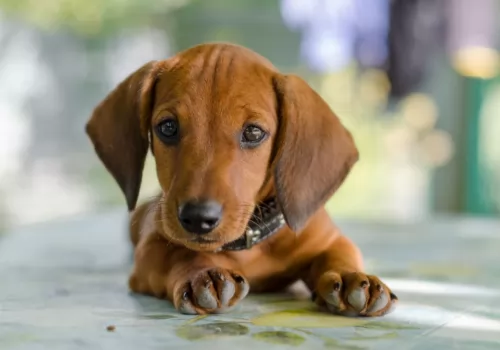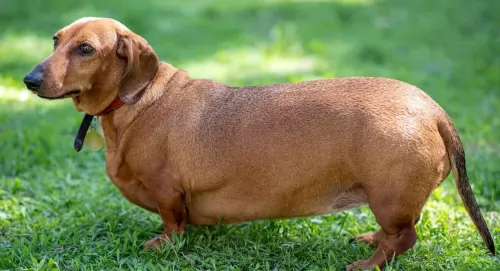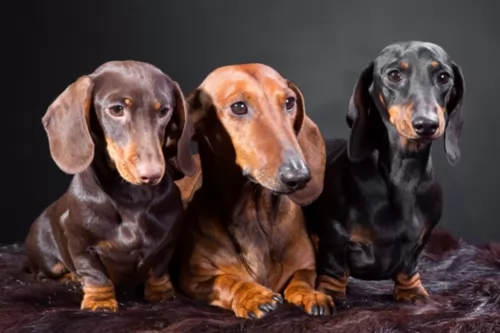 MyDogBreeds
MyDogBreeds Dachshund is originated from Germany but American Staffordshire Terrier is originated from United Kingdom. Dachshund may grow 20 cm / 7 inches shorter than American Staffordshire Terrier. Dachshund may weigh 12 kg / 26 pounds lesser than American Staffordshire Terrier. Both Dachshund and American Staffordshire Terrier has almost same life span. Both Dachshund and American Staffordshire Terrier has almost same litter size. Both Dachshund and American Staffordshire Terrier requires Low maintenance.
Dachshund is originated from Germany but American Staffordshire Terrier is originated from United Kingdom. Dachshund may grow 20 cm / 7 inches shorter than American Staffordshire Terrier. Dachshund may weigh 12 kg / 26 pounds lesser than American Staffordshire Terrier. Both Dachshund and American Staffordshire Terrier has almost same life span. Both Dachshund and American Staffordshire Terrier has almost same litter size. Both Dachshund and American Staffordshire Terrier requires Low maintenance.
 The Dachshund originated in Germany. He was used as a hunting dog with his origins starting way back in the 15th century already. The small dog was developed to hunt for animals that buried themselves deep underground such as badgers. The shape of the dog and his courage and bravery allowed him to take on the badger.
The Dachshund originated in Germany. He was used as a hunting dog with his origins starting way back in the 15th century already. The small dog was developed to hunt for animals that buried themselves deep underground such as badgers. The shape of the dog and his courage and bravery allowed him to take on the badger.
There has been a lot of debate as to whether the Dachshund is a hound or terrier, and it was decided that the Dachshund is a hound that became a terrier, and which displays some of the best qualities of both.
It was in 1881 that the Dachshund Club of England was formed and the German Deutscher Teckelklub was formed in 1888. The small dog gained popularity in America and the Dachshund Club of America was founded in 1895.
 The American Staffordshire Terrier is a part of all the confusion surrounding the group of “pit bulls”. The American Staffordshire Terrier is directly related to the English Bull Terrier and English Terrier. The breed of the English Staffordshire Terrier was bred in the early 19th century in the West Midlands. It was not until later that the breed came from Staffordshire. These English Staffordshire Terriers are also the source of contention by breeders who insist it was the Fox Terrier, White English Terrier, Tan and Black Terrier that are the ancestors of the English Staffordshire Terrier.
The American Staffordshire Terrier is a part of all the confusion surrounding the group of “pit bulls”. The American Staffordshire Terrier is directly related to the English Bull Terrier and English Terrier. The breed of the English Staffordshire Terrier was bred in the early 19th century in the West Midlands. It was not until later that the breed came from Staffordshire. These English Staffordshire Terriers are also the source of contention by breeders who insist it was the Fox Terrier, White English Terrier, Tan and Black Terrier that are the ancestors of the English Staffordshire Terrier.
These terriers (AKA pit bull terrier) came to the United States in the mid 1800’s. By the late 1890’s they were accepted by the United Kennel Club (UKC)as the American Pit Bull Terrier – a new and distinct breed. There were also some that were accepted into the AKC as the Staffordshire Terrier. In England they were still known as the American Staffordshire Terrier. When the AKC accepted the breed in 1936 they were given a new standard, new purpose and new group – the terrier. In 1969 the American Kennel Club recognized these dogs as American Staffordshire Terriers and refused to recognize the American Pit Bull Terrier. The name was changed to move the breed away from its characterization as a bull fighter and to distinguish it from the smaller English Staffordshire Terrier. All American Staffordshire Terriers are directly related to the American Pit Bull Terriers.
 Known as Badger Dogs, Sausage Dogs or Doxies, the Dachshund is known for his long body, his sharp, pointed face and the short legs with the large front paws.
Known as Badger Dogs, Sausage Dogs or Doxies, the Dachshund is known for his long body, his sharp, pointed face and the short legs with the large front paws.
He stands at about 21-28 cm while the female may be 20-25 cm and weighing 6 to 15kg. He is the smallest of the hound dogs, with the standard size dachshund being developed to scent and chase badgers and other animals.
There are different Dachshund coat varieties – the smooth coat, the long-haired Dachshund and the wire-haired dachshund. They also come in a number of solid colors such as brown, red, tan, chocolate and black.
The dachshund is an energetic,social little dog with a loving personality. He’ll love to lie as close as possible to you on the couch and be with you wherever you are. Training and socialization is important so he doesn’t become too protective so that he wants to go for anyone who comes near.
He can be stubborn but he is also protective of his human family. Dachshunds are known for their tendency to bark but training and socialization can help tremendously to make him obedient and relaxed around humans and pets.
He is small enough to be a great pet in the city or in the country. He loves to spend time indoors- as well as outdoors. He can become a loving companion and gets on well with children and pets in the house. In spite of his small size, he makes a good watchdog.
 The American Staffordshire Terrier is a strong, powerful dog – stocky, muscular and graceful. At one point in time the American Staffordshire Terrier and the American Pit Bull Terrier were considered to be the same breed. Even today there are those that make that argument, but they have been recognized outside the AKC as separate breeds. The AKC only recognizes the American Staffordshire Terrier and not the APBT. However – even though there have been decades of separation in breeding the American Staffordshire Terrier and the American Pit Bull Terrier are the very same dogs genetically.
The American Staffordshire Terrier is a strong, powerful dog – stocky, muscular and graceful. At one point in time the American Staffordshire Terrier and the American Pit Bull Terrier were considered to be the same breed. Even today there are those that make that argument, but they have been recognized outside the AKC as separate breeds. The AKC only recognizes the American Staffordshire Terrier and not the APBT. However – even though there have been decades of separation in breeding the American Staffordshire Terrier and the American Pit Bull Terrier are the very same dogs genetically.
The American Staffordshire Terrier has a broad skull, high set ears and pronounced cheek bones. Their ears should not be cropped by AKC standards and their eyes are far apart, round and dark. With a medium sized muzzle and a heavy muscular back, they are as powerful as they look, if not more so. Most have black noses. The AmStaff has a broad, deep chest with wide set forelegs and compact feet. The tail is short and tapered and it should not be docked.
 The Dachshund may be small but he is courageous, brave and loyal. He gets on well with children and pets in the home but care needs to be taken because of his long back.These dogs are prone to disk problems so you have to be careful with rough and tumble from children.
The Dachshund may be small but he is courageous, brave and loyal. He gets on well with children and pets in the home but care needs to be taken because of his long back.These dogs are prone to disk problems so you have to be careful with rough and tumble from children.
Dog experts say that the different kinds of Dachshunds produce different personalities and that the longer-coated one is more amicable than the short-coat variety. Whichever variety you choose, they are guaranteed to entertain and delight you and be a loyal, loving companion.
 The American Staffordshire Terrier is a loving, gentle dog that wants nothing more than to be with and please his people. Contrary to his reputation as a “killer”, this dog is actually a lover. They are great with children and want to be a part of the family. They even think they are lap dogs, regardless of their size. They are never going to be aggressive toward people and even though they are not one-person dogs, they are loyal, and they are devoted to the family and the “leader of the pack”.
The American Staffordshire Terrier is a loving, gentle dog that wants nothing more than to be with and please his people. Contrary to his reputation as a “killer”, this dog is actually a lover. They are great with children and want to be a part of the family. They even think they are lap dogs, regardless of their size. They are never going to be aggressive toward people and even though they are not one-person dogs, they are loyal, and they are devoted to the family and the “leader of the pack”.
This breed can tell who is their friend and who is not. They are not aggressive, but they will protect their own. They are courageous, confident, attentive, bold and strong-willed. The AmStaff gets along with other dogs most of the time, but they will never back down from a challenge and should never be left unsupervised with another dog. They should not be loose in a neighborhood or at a dog park. No matter how much you trust your American Staffordshire Terrier they can be killers in any fight with another dog.
In addition to this you must socialize and train your AmStaff. You need to be the pack leader and be in control. The AmStaff wants to please you so for a strong leader they will respond positively to positive training. They are intelligent and pick up quickly on what you want them to do. However, they are incredibly strong physically so training them to heel and walk with you obediently is a must. A well trained and exercised American Staffordshire Terrier is a happy dog and a loyal family dog.
 The life expectancy of the Dachshund is 12 to 16 years. With good care which includes good nutrition he can reach mature years. However there are always some dog diseases that are worth knowing about so that you can steer your pet away from them.
The life expectancy of the Dachshund is 12 to 16 years. With good care which includes good nutrition he can reach mature years. However there are always some dog diseases that are worth knowing about so that you can steer your pet away from them.
One of these is obesity, and the Dachshund is prone to developing obesity. Never overfeed him and ensure he gets his regular exercise which can be walks and ball games. Check with your vet if you’re unsure about how to feed him. Essentially, the amount of food you give a dog depends on the size of your dog, his age and his activity levels.
Be sure to provide high-quality food and monitor his intake. Your vet is always there to advise on the correct food and amount that can help him remain healthy.
Unfortunately, this dog’s shape – the long back – makes the dog more prone to disc herniation. With some Dachshunds having a gene that creates mineral deposits in the discs in the spine, the risk of herniation is higher.
A large percentage of dachshunds have intervertebral disc disease. Encourage your Dachshund not to jump down off a bed or couch, but rather provide some steps for him to get to out of reach places.
 For the most part the American Staffordshire Terrier, like most of the “pit bulls” is a hearty, healthy dog. They have a few tendencies that breeders should test for including hip dysplasia, allergies, and heart issues. They can test for Cerebellar ataxia, which has affected the AmStaff with a progressive decline in their ability to control their muscles and coordination.
For the most part the American Staffordshire Terrier, like most of the “pit bulls” is a hearty, healthy dog. They have a few tendencies that breeders should test for including hip dysplasia, allergies, and heart issues. They can test for Cerebellar ataxia, which has affected the AmStaff with a progressive decline in their ability to control their muscles and coordination.
 The Dachshund is a medium shedder and if you choose the short haired dog, you’re going to have a low maintenance pet.
The Dachshund is a medium shedder and if you choose the short haired dog, you’re going to have a low maintenance pet.
The long haired Dachshund will require more regular brushing but the short-haired Dachshund is a low maintenance dog that will require a brush once a week.
While brushing him, you can be checking his ears and nails at the same time. All dogs with floppy ears need to have them checked for ear infections. Also, maintain good oral hygiene with your Dachshund by brushing his teeth 2 or 3 times a week.
 feed You can feed your American Staffordshire Terrier either commercially purchased food or food you make yourself if the quality is high, nutrition is good, and the amount eaten is determined by the owner. Do not free feed. The AmStaff has the tendency to become obese. Its ok to use treats for training and rewards, as long as its use is controlled.
feed You can feed your American Staffordshire Terrier either commercially purchased food or food you make yourself if the quality is high, nutrition is good, and the amount eaten is determined by the owner. Do not free feed. The AmStaff has the tendency to become obese. Its ok to use treats for training and rewards, as long as its use is controlled.
As previously mentioned the American AmStaff Terrier has a tendency toward a few health issues. Hip Dysplasia – this condition causes a lot of pain and disability. It leads to different types of arthritis and degenerative joint disease. Cardiac Issues – Congenital heart disease consists of vessel malformation and lesions.
The AmStaff can be susceptible to Autoimmune Thyroiditis. This is a form of hypothyroidism developed by dogs. It is usually seen between 2 and 5 years of age. Continual retesting is recommended.
This is the most dangerous disease possibility that the American Staffordshire Terrier faces. There is a test for this condition which causes the AmStaff to display an inability to control their muscles and a loss of balance, to the point of falling. This is a progressive disease that often leads to euthanasia. The Staffordshire Terrier Club of America suggests that AmStaffs carrying the NCL genes should never be bred.
The American Staffordshire Terrier is an energetic, and athletic dog that loves to play and needs plenty of exercise. This breed is oriented to people and should never be left alone in the yard all day as a way for her to exercise. She needs you to play with her. If you cannot do this, then you should not own this breed of dog. This breed also loves to play canine sports. They thrive on games like dock diving, agility and obedience competitions. They excel at search and rescue. These are competitive dogs that want nothing more then to please their people.